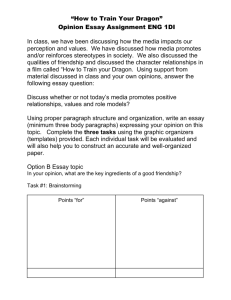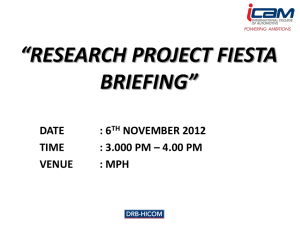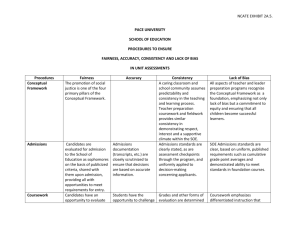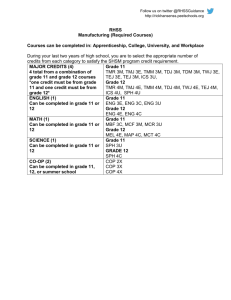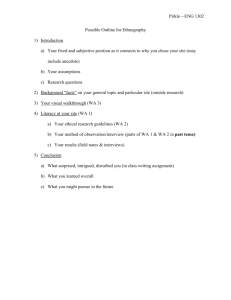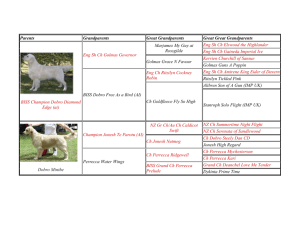Student Learning Assessment Program
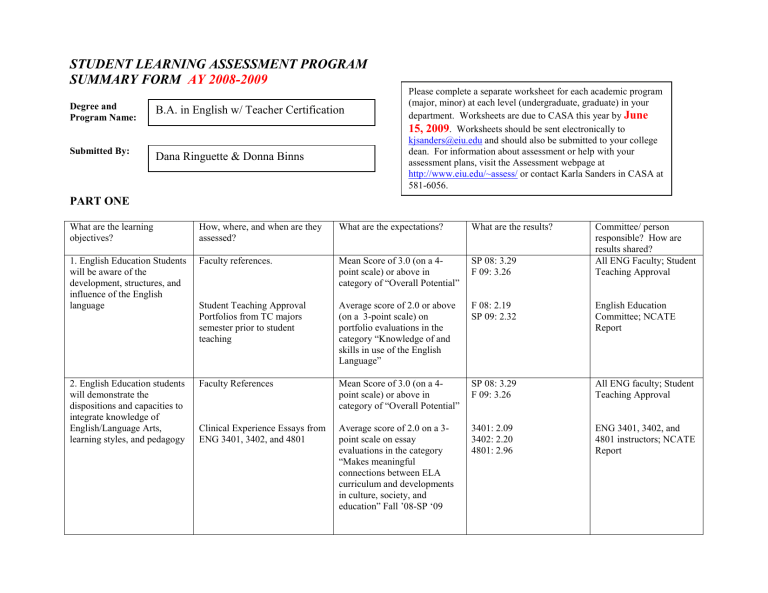
STUDENT LEARNING ASSESSMENT PROGRAM
SUMMARY FORM
AY 2008-2009
Degree and
Program Name:
Submitted By:
B.A. in English w/ Teacher Certification
Dana Ringuette & Donna Binns
PART ONE
What are the learning objectives?
1. English Education Students will be aware of the development, structures, and influence of the English language
2. English Education students will demonstrate the dispositions and capacities to integrate knowledge of
English/Language Arts, learning styles, and pedagogy
How, where, and when are they assessed?
Faculty references.
Student Teaching Approval
Portfolios from TC majors semester prior to student teaching
Faculty References
Clinical Experience Essays from
ENG 3401, 3402, and 4801
Please complete a separate worksheet for each academic program
(major, minor) at each level (undergraduate, graduate) in your department. Worksheets are due to CASA this year by June
15, 2009 . Worksheets should be sent electronically to kjsanders@eiu.edu
and should also be submitted to your college dean. For information about assessment or help with your assessment plans, visit the Assessment webpage at http://www.eiu.edu/~assess/ or contact Karla Sanders in CASA at
581-6056.
What are the expectations? What are the results?
Mean Score of 3.0 (on a 4SP 08: 3.29 point scale) or above in category of “Overall Potential”
Average score of 2.0 or above
F 09: 3.26
F 08: 2.19
SP 09: 2.32 (on a 3-point scale) on portfolio evaluations in the category “Knowledge of and skills in use of the English
Language”
Mean Score of 3.0 (on a 4point scale) or above in category of “Overall Potential”
Average score of 2.0 on a 3point scale on essay evaluations in the category
“Makes meaningful connections between ELA curriculum and developments in culture, society, and education” Fall ’08-SP ‘09
SP 08: 3.29
F 09: 3.26
3401: 2.09
3402: 2.20
4801: 2.96
Committee/ person responsible? How are results shared?
All ENG Faculty; Student
Teaching Approval
English Education
Committee; NCATE
Report
All ENG faculty; Student
Teaching Approval
ENG 3401, 3402, and
4801 instructors; NCATE
Report
#2 Continued
3. English Education students will understand the range and influence of print and nonprint media in contemporary culture.
4. English Education students will understand research and theory in English Education.
Unit Plans from ENG 3401 and
3402.
Student Teaching Approval
Portfolios from TC Majors prior to student teaching
Content Area State Exam
Student Teaching Approval
Portfolios from TC Majors prior to student teaching
Average score of 3.0 on a 5point scale on lesson/unit plan assessment in the category
“Diverse Strategies: Content
Knowledge” F ’07-SP ‘08
Average score of 2.0 on a 3point scale on portfolio evaluations in the category
“Knowledge of the range and influences of print and nonprint media and technology in contemporary cultures”
80% of Student Teaching
Candidates pass exam
Average score of 2.0 on a 3point scale in the category
“Knowledge of research theory and findings in English language arts”
(Continue objectives as needed. Cells will expand to accommodate your text.)
3401: 4.47
3402: 4.54
F 08: 2.19
SP 09: 2.64
SP 08: 93%*
F 08: 100%
F 08: 2.00
SP 09: 2.55
ENG 3401 and 3402 instructors; NCATE
Report
English Education
Committee; NCATE
Report
College of Education &
Professional Studies
(CEPS); NCATE Report
English Education
Committee; NCATE report.
*The one student who did not pass the ELA Content Area Exam in Spring 2008 passed it in Fall 2008.
PART TWO
Describe what your program’s assessment accomplishments since your last report was submitted. Discuss ways in which you have responded to the CASA Director’s comments on last year’s report or simply describe what assessment work was initiated, continued, or completed.
Our English Major with Teacher Certification has eight assessments that align with the objectives listed above, the NCATE/NCTE Standards, and
Illinois State Standards. Although the data from all eight assessments is to extensive to list here, we received National Recognition (with
absolutely NO conditions) from our Specialty Program Area, the NCTE (National Council of Teachers of English), with the first submission of our program’s most recent NCATE Report in September 2008. According to Dr. Doug Bower, only about 40% of English Language Arts programs received National Recognition from the NCTE on the first try, so we believe that this result speaks volumes for the quality of our program and the eight assessments we utilize.
Here is an overview of the eight assessments (with areas covered on the left and our assessments on the right):
1. (Required)-CONTENT KNOWLEDGE: The English Language Arts Content Exam
2. (Required)-CONTENT KNOWLEDGE: Comprehensive, Professional Portfolios
3. (Required)-PEDAGOGICAL AND PROFESSIONAL KNOWLEDGE, SKILLS, AND DISPOSITIONS : Unit Plans from ENG 3401 and
3402 (Live Text)
4. (Required)-PEDAGOGICAL AND PROFESSIONAL KNOWLEDGE, SKILLS, AND DISPOSITIONS: Student Teaching Assessment
(Live Text)
5. (Required)-EFFECTS ON STUDENT LEARNING: Student Teaching Unit/Learning Center Plan (Live Text)
6. (Required): Additional assessment that addresses NCTE standards : Clinical Experience Essay Assessments from ENG 3401, ENG 3402, and ENG 4801
7. (Optional): Additional assessment that addresses NCTE standards: APT Exam Results
8. (Optional): Additional assessment that addresses NCTE standards: Yellow Sheet Faculty Reference Evaluations
In summary, we use 3 Live Text Assessments; 2 Exam Assessments; and 3 Departmental Pen & Paper Assessments.
The Student Teaching Approval Portfolio is a key assessment that relates to content knowledge. The portfolios contain the following artifacts, which demonstrate the development of our teacher certification candidates throughout their professional coursework:
Table of Contents
Résumé
Completed “Checklist for English Majors”
Philosophy of teaching literature and composition
3 writing samples-- one from a Methods course and two from other English courses
Unit plans from ENG 3401 and ENG 3402
Evidence of professional organization membership
Evidence of presentation at English Studies Student Conference (i.e. program)
Clinical experience essays from ENG 3401, ENG 3402, and ENG 4801
In addition, the multiple writing samples evaluated in the portfolio and the Clinical Experience Essay assessments demonstrate attention to our students’ writing. Students are required to present at the English Studies Student Conference, which demonstrates an emphasis on speaking. Our state content area exam includes sections on Writing & Research as well as Speaking & Listening, and our teacher certification candidates consistently perform well on that exam. Our Student Teaching Approval Portfolio rubric includes the category “Knowledge of the practices of
oral, visual, and written literacy” and in Fall 2008 we added “Knowledge of composing processes.” Our Yellow Faculty Evaluation sheets include categories in both writing and speaking. Mean scores in these categories consistently meet or exceed the “Acceptable” range.
The Live Text Student Teaching rubric and the Unit Plan rubric contain domains involving “Diverse Societies,” which demonstrates attention to global citizenship. In addition, our Clinical Experience Essay rubric includes the category “Uses ELA extensively and creatively to help students become familiar with their own and others’ cultures. Our rubrics also contain categories that relate to critical thinking. For example, our Clinical
Experience Essay rubric includes the categories “Uses the results of reflective practice” and “Designs and implements instructions and assessment that assist students in developing habits of critical thinking.” Our mean scores in all of these assessment categories meet or exceed the
“Acceptable” range. In fact, our students consistently earn mean scores at or above a 4.0 on a five-point scale in all categories on the Student
Teaching Evaluation rubric.
With regard to our program assessments, the NCTE response to our report indicated, “As data are collected from the assessments submitted, the program seems to have a systemic evaluation system that will give evidence of candidate performance in all areas, making the improvement of candidate performance and the strengthening of the program extremely relevant and data driven.”
In addition, we received the following statement regarding our program’s many strengths:
“Even before student teaching, the program requires that candidates prepare an ELA Education
Comprehensive Portfolio (Assessment #2) and Methods Course Lesson Plan (Assessment #3) in anticipation of using them within the program. Also, there is a strong focus on candidates' planning for and engagement with diverse students in field settings (especially with Impact on P-12 and Clinical
Experience Essays, Assessments #5 and #6).
There is an emphasis on integrating a variety of ELA strategies in response to a variety of diverse learners.
The program recently strengthened the study of multicultural and young adult literature and focuses on student-mandated speech/communication content, which further enhances curriculum.
Field work is intertwined with coursework, providing hands-on activities for candidates as they move through their sequence.
The program requires early and sustained contact with professional activity, including presentations as well as attendance.
Evaluation by many faculty members allows the program to have a complete understanding of candidate dispositions.”
PART THREE
Summarize changes and improvements in curriculum, instruction, and learning that have resulted from the implementation of your assessment program. How have you used the data? What have you learned? In light of what you have learned through your assessment efforts this year and in past years, what are your plans for the future?
Although our eight assessments received a favorable response from the NCTE, we recognize the need for improvements. Consequently, we are making the following modifications:
Adding “Literature Narratives” to the Comprehensive, Professional Portfolios beginning Fall 2009
Added “Knowledge of writing processes” category to the Portfolio Assessment in Fall 2008
Adding “Candidates engage their students in activities that demonstrate the role of arts and humanities in learning” category to the Clinical
Experience Essays rubric in Fall 2009
In Fall 2006, our English Department made changes to the curriculum for English Majors with Teacher Certification. These changes took effect in
Fall 2007 for both undergraduate English majors and post-baccalaureate candidates seeking teacher certification. The changes were made to better align with NCATE/NCTE standards and to improve our program of study for teacher certification candidates. The most significant changes were as follows:
ENG 4903: Young Adult Literature changed from being a recommended course to a required course for teacher certification candidates (See Group 1 in the curriculum attachment).
The number of hours required in Group 2, Focused Study in Multi-cultural Literatures, increased from three hours to six hours. All teacher certification candidates take ENG 3705: American Multi-cultural Literature and they must select one other multi-cultural literature course from the courses listed under Group 2 in the curriculum.
These changes strengthened our program of study in multi-cultural literature and young adult literature. By strengthening our multicultural literature requirements, we also believe that we have promoted global citizenship. Although both topics have been, and will continue to be, covered in our Methods of Teaching Literature course (ENG 3402), our English Department approved these changes to ensure that candidates gain a better understanding of these areas of study. Consequently, our candidates should gain an improved “knowledge of, and uses for, an extensive range of literature” (NCTE Standard 3.5). We also hope that adding Literacy Narratives (which will be completed in ENG 3402) to the Student
Teaching Approval Portfolio will allow us to better assess that category.
We have added an emphasis on case studies of classroom management issues to ENG 4801: Integrating the English Language Arts. As mentioned earlier, our teacher certification candidates consistently score well in each category on the Student Teaching Assessment rubric. In each category, the mean score for our student teachers meets or exceeds 4.0, which demonstrates that our student teachers succeed in their most substantial
classroom teaching experiences. However, the lowest mean scores occurred in the subcategories “Monitoring Student Behavior” and “Response to
Student Misbehavior” under Category #1 “Diverse Students.” Nevertheless, mean scores in both subcategories exceed 4.3. Although a 4.3 on a five-point scale still indicates some strength in these categories, we hope that more attention to these areas in our capstone teaching-oriented class
(ENG 4801) in the form of actual case studies involving student misbehavior will better prepare our student teachers to meet such challenges.
